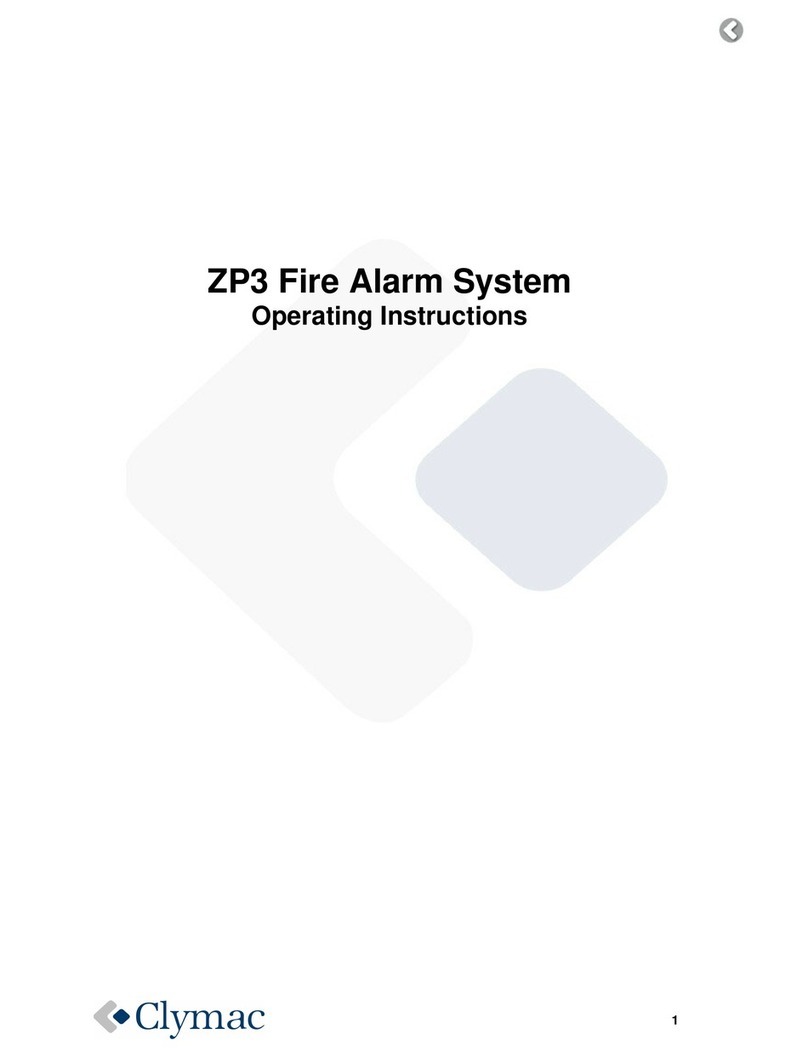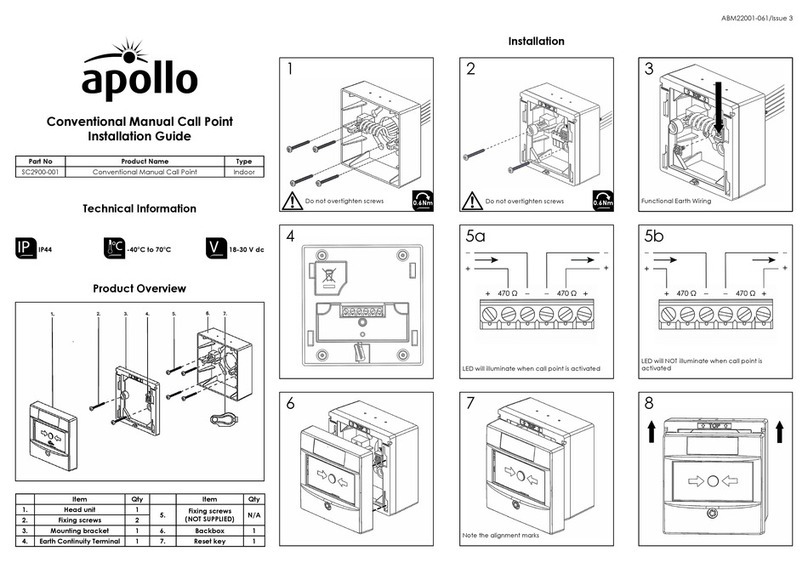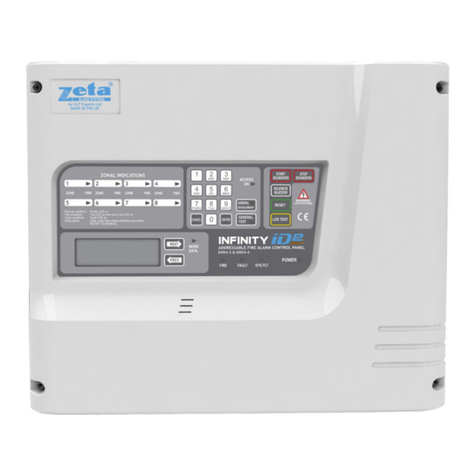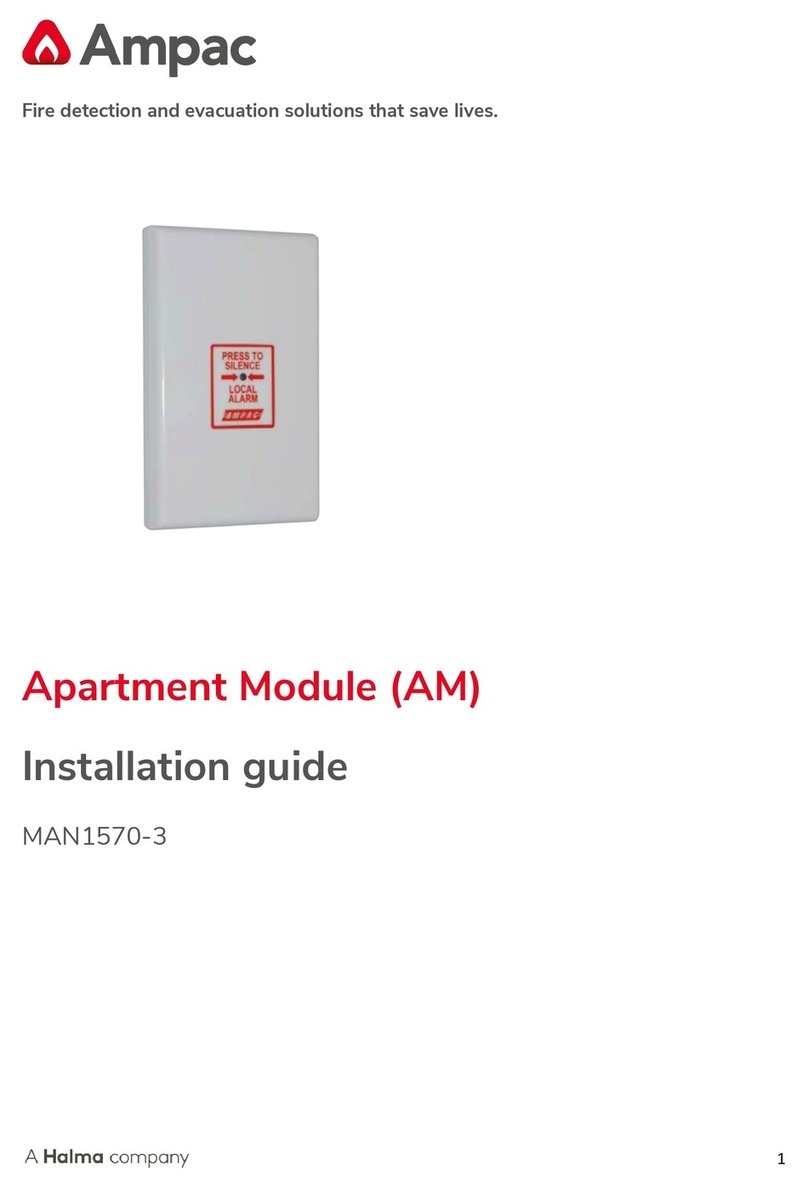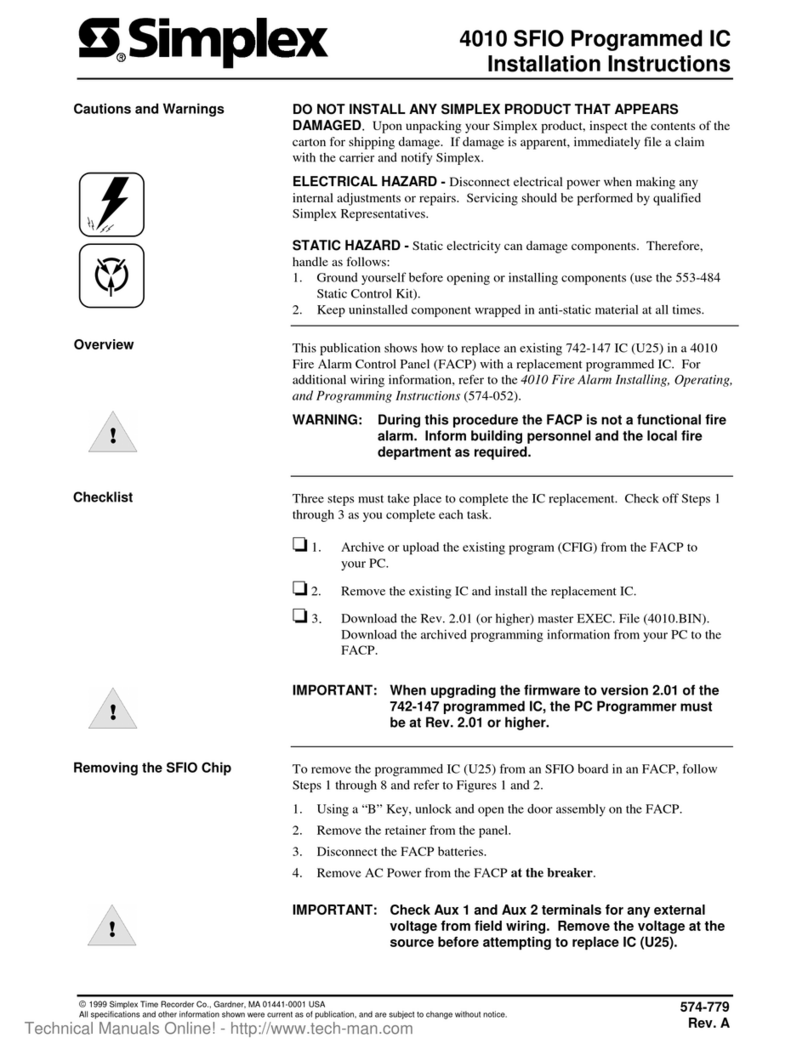Global JUNO-NET Manual

OPERATION
&
MAINTENANCE
MANUAL
JUNO-NET
Fire Alarm Control Panel
REVISION 0.7a
16-04-2004

JUNO-NET
CONTENTS
SECTION 1 -
1.1 Description of the fire control panel fascia................................................
1.2 Alarm.................................................................................................
1.9 Caretaker Test Mode.............................................................................
1.10 Disablements......................................................................................
1.10.1 Selected detectors..............................................................
1.10.3 Fire Brigade Transmission....................................................
2.1 Printer paper replacement.....................................................................
2.2 SIM CARD replacement.......................................................................
2.3 Main control board fuse........................................................................
2.4 Connection board fuses........................................................................
2.5 Sub-panel fuses...................................................................................
2.6 Battery voltage and charger checks.........................................................
2.7 Use of programming functions for maintenance.......................................
2.8 Getting into Programming Mode............................................................
2.9 Logbook.............................................................................................
2.10 Event data sheet...................................................................................
OPERATION
1.3 Reset the system...................................................................................
1.4 Sound and silence the alarms.................................................................
1.5 Read the Fire, Fault, Test and Disabled queues..........................................
1.6 Active Delays.......................................................................................
1.7 Lamp Test............................................................................................
1.8 Perform a fire drill.................................................................................
1.10.2 Auxiliary relays...................................................................
1.11 If the panel displays a fault.....................................................................
1.12 If the panel displays a pre-alarm............................................................
SECTION 2 - MAINTENANCE
2
4
5
5
6
7
8
9
10
12
12
13
13
14
14
15
16
17
17
17
18
19
22
27
28
This manual has been written for panel software revision 2.05. Older or new
versions of panel software will be similar but some details may differ.
1
OPERATION & MAINTENANCE MANUAL
REVISION 0.7a
16-04-2004

JUNO-NET
STATUS
FIRE ALARM SYSTEM
FIRE
FAULT
PRE-ALARM
TEST
DISABLED
SYSTEM ON
ALARM FAULT
SUPPLY FAULT
PROC. FAULT
TRANS. FAULT SOUND ALARMS
PAPER FEED
LAMP TEST
SYSTEM RESET
ALARM SILENCE
DISABLED
TEST
FAULT
FIRE
AUXILIARY
RELAYS
FIRE BRIGADE
TRANSMISSION
SELECTED
DETECTORS
ACTIVE
DELAYS
FIRE BRIGADE
ACKNOWLEDGED
ALARM DISPLAY
JUNO-NET
MANUFACTURED TO THE
REQUIREMENTS OF
EN54 Pt 2 & Pt 4 1999
FAULTS CONTROLS DISABLEMENTS
QUEUE REVIEW
1.1 DESCRIPTION OF THE FIRE CONTROL PANEL FASCIA
1
2
3
4
5
6
7
8
9
10 11
12 13
14
15
16 17 18
19
21
23 22
20
25 24
27 26
29
30
32
33
31
28
34 35
FIRE
FAULT
PRE-ALARM
TEST
DISABLED
SYSTEM ON
ALARM FAULT
: If the LED is RED it indicates that there is a fire situation.
: If the LED is AMBER it indicates a fault situation. Additional information will be shown on the LCD display
and, if applicable, on the LEDs in the FAULTS section of the main panel (i.e. 7, 8, 9, 10).
: If the LED is AMBER it indicates that a detector is in PRE-ALARM.
: If the LED is AMBER it indicates that the panel is in a test mode.
: If the LED is AMBER it indicates that at least one disablement exists.
: If the LED is GREEN it means that the panel is in ACTIVE mode. If the LED is flashing GREEN then the
panel is in INSTALLATION mode.
: If the LED is AMBER it indicates that there is a problem with a loop sounder or conventional sounder
circuit. This could be an open or short circuit or a blown alarm fuse.
: If the LED is AMBER it indicates that there is a Primary Fault, a Battery Fault or that there is an Earth
Fault.
: If the LED is AMBER it indicates that there is 5 Volt fault or a program failure.
: If the LED is AMBER it indicates that there is an open or short circuit in the fire brigade
transmission circuit.
SUPPLY FAULT
PROCESSOR FAULT
TRANSMISSION FAULT
LCD DISPLAY
1
2
3
4
5
6
7
8
9
10
OPERATION
SECTION 1
2
OPERATION & MAINTENANCE MANUAL
REVISION 0.7a
16-04-2004

FIRE BRIGADE ACKNOWLEDGED: If the LED is AMBER it indicates that the transmission has been acknowledged.
: Pressing this button will silence all alarm sounders and buzzers during a FIRE condition as well as
all buzzers during a FAULT condition.
: If the LED is AMBER it indicates that a FIRE condition has been silenced.
: Pressing this button restores the panel to its normal operating condition after an alarm. Alarms must
be silenced before a SYSTEM RESET can be performed. A SYSTEM RESET does not clear any settings or disablements;
it only clears FIRE and FAULT conditions (and then only if the source of the FIRE or FAULT has been cleared).
: Whilst this button is depressed all of the panel’s LEDs will be illuminated and all of the LCD display pixels
will be set to black. Use this button to confirm the LEDs and LCD display are functional.
: Pressing this button will activate all sounders and panel buzzers (main panel and Repeaters).
Pressing the button again or pressing ALARM SILENCE ( ) will silence the sounders and buzzers.
: If the LED is RED it means that the SOUND ALARMS function has been activated.
: Delays can be configured for the sounders, I/O modules and fire brigade transmission using the
programming functions. Pressing this button enables or disables these delays.
: If the LED is AMBER it means that the delays are active.
: Using the programming functions individual detectors can be set for SELECTIVE
DISABLEMENT. When this button is activated those detectors will be disabled (isolated). Note that this button will only
operate if at least one detector has been set for SELECTIVE DISABLEMENT.
: If the LED is AMBER it means that the selected detectors are isolated.
: Pressing this button disables or enables the fire brigade transmission.
: If the LED is AMBER it means that the transmission is disabled.
: Pressing this switch disables or enables all the relay and I/O module outputs.
: If the LED is AMBER it means that the relay and I/O module outputs are disabled.
: If there are disablements then pressing this button will show the disablements on the LCD display. If there
are more disablements than can be shown on the LCD display at one time then subsequent presses of this button will
step through all the disablements.
: If the LED is AMBER it means that there is at least one disablement.
: If there are ZONES in test mode then pressing this button will show those ZONES on the LCD display. If more
ZONES are in test mode than can be shown on the LCD display at one time then subsequent presses of the button will
step through all the ZONES in test mode.
: If the LED is AMBER it means that one or more ZONES are in test mode.
: If there is more than one FAULT, or if there is at least one FAULT and a FIRE, pressing this button will display
the next FAULT report on the LCD display for 20 seconds. Subsequent presses will step through all the FAULT reports.
: If the LED is flashing AMBER it means that are FAULT reports to be reviewed. If the LED is steady AMBER then
all FAULT reports have been reviewed.
: If there is more than one FIRE pressing this button will display the next FIRE report on the LCD display for 20
seconds. Subsequent presses will step through all the FIRE reports.
: If the LED is flashing RED it means that there are FIRE reports to be reviewed. If the LED is steady RED then all
FIRE reports have been reviewed.
: Pressing this switch will advance paper through the printer.
: When using the Remote Infra-Red Keypad it is important that the remote is pointed towards
this sensor.
ALARM SILENCE
ALARM SILENCE
SYSTEM RESET
LAMP TEST
SOUND ALARMS
12
SOUND ALARMS
ACTIVE DELAYS
ACTIVE DELAYS
SELECTED DETECTORS
SELECTED DETECTORS
FIRE BRIGADE TRANSMISSION
FIRE BRIGADE TRANSMISSION
AUXILIARY RELAYS
AUXILIARY RELAYS
DISABLED
DISABLED
TEST
TEST
FAULT
FAULT
FIRE
FIRE
PAPER FEED
INFRA-RED SENSOR
11
12
13
14
15
16
17
18
19
20
21
22
23
24
25
26
27
28
29
30
31
32
33
34
35
OPERATION JUNO-NET
1.1 DESCRIPTION OF THE FIRE CONTROL PANEL FASCIA (continued...)
3
OPERATION & MAINTENANCE MANUAL
REVISION 0.7a
16-04-2004

To do this press the ALARM SILENCE .
Pressing this button will:
Stop the sounders sounding
Make the panel buzzer intermittent
Light the AMBER ALARM SILENCE
Stop sounders queued for delayed
activation
The STATUS - FIRE will remain lit RED.
button
LED
LED
At the fire control panel, the STATUS -
FIRE will illuminate RED.
The fire control panel buzzer will
sound.
The location of the alarm (or alarms)
will be shown on the fire control panel
If more than one alarm has occurred
the QUEUE REVIEW FIRE will
RED indicating that further fire
reports can be displayed on the LCD
display by pressing the QUEUE
REVIEW FIRE .
If fitted, the external RED Zone LEDs
will be illuminated for the Zones in
FIRE.
LED
LCD display.
LED
button
flash
JUNO-NET
1.2 ALARM
If the fire alarm control panel signals an ALARM the following events will take place:
The sounders, I/O modules and other outputs will operate in accordance with their programming.
STATUS
STATUS
FIRE ALARM SYSTEM
FIRE ALARM SYSTEM
FIRE
FIRE
FAULT
FAULT
PRE-ALARM
PRE-ALARM
TEST
TEST
DISABLED
DISABLED
SYSTEM ON
SYSTEM ON
ALARM FAULT
ALARM FAULT
SUPPLY FAULT
SUPPLY FAULT
PROC. FAULT
PROC. FAULT
TRANS. FAULT
TRANS. FAULT
SOUND ALARMS
SOUND ALARMS
PAPER FEED
PAPER FEED
LAMP TEST
LAMP TEST
SYSTEM RESET
SYSTEM RESET
ALARM SILENCE
ALARM SILENCE
DISABLED
DISABLED
TEST
TEST
FAULT
FAULT
FIRE
FIRE
AUXILIARY
RELAYS
AUXILIARY
RELAYS
FIRE BRIGADE
TRANSMISSION
FIRE BRIGADE
TRANSMISSION
SELECTED
DETECTORS
SELECTED
DETECTORS
ACTIVE
DELAYS
ACTIVE
DELAYS
FIRE BRIGADE
ACKNOWLEDGED
FIRE BRIGADE
ACKNOWLEDGED
ALARM DISPLAY
ALARM DISPLAY
JUNO-NET
JUNO-NET
MANUFACTURED TO THE
REQUIREMENTS OF
EN54 Pt 2 & Pt 4 1999
MANUFACTURED TO THE
REQUIREMENTS OF
EN54 Pt 2 & Pt 4 1999
FAULTS
FAULTS
CONTROLS
CONTROLS
DISABLEMENTS
DISABLEMENTS
QUEUE REVIEW
QUEUE REVIEW
2
2
3
3
4
4
5
5
6
6
7
7
8
8
9
9
10
10
11
11
12
12
13
14
14
15
15
16
16
17
17
18
18
19
19
21
21
23
23
22
22
20
20
25
25
24
24
27
27
26
26
29
29
30
30
32
32
33
31
31
28
28
34
34
35
35
LCD DISPLAY
LCD DISPLAY
EVACUATE IN ACCORDANCE WITH THE SITE PROCEDURE
ONLY WHEN AUTHORISED should you silence the alarms.
DO NOT PRESS UNTIL THE ALARM CONDITION HAS BEEN DEALT WITH.SYSTEM RESET
OPERATION
4
OPERATION & MAINTENANCE MANUAL
REVISION 0.7a
16-04-2004

On the fire control panel:
Press the SOUND ALARMS .
All sounders turn on
The SOUND ALARMS illuminates RED
The fire control panel buzzer sounds
Press the ALARM SILENCE .
The sounders turn off
The SOUND ALARMS extinguishes
The fire control panel buzzer stops sounding
button
LED
button
LED
1.4 SOUND AND SILENCE THE ALARMS
This section shows you how to turn on and turn off all the sounders in an installation. It is identical to a fire
drill procedure.
STATUS
FIRE ALARM SYSTEM
FIRE
FAULT
PRE-ALARM
TEST
DISABLED
SYSTEM ON
ALARM FAULT
SUPPLY FAULT
PROC. FAULT
TRANS. FAULT SOUND ALARMS
PAPER FEED
LAMP TEST
SYSTEM RESET
ALARM SILENCE
DISABLED
TEST
FAULT
FIRE
AUXILIARY
RELAYS
FIRE BRIGADE
TRANSMISSION
SELECTED
DETECTORS
ACTIVE
DELAYS
FIRE BRIGADE
ACKNOWLEDGED
ALARM DISPLAY
JUNO-NET
MANUFACTURED TO THE
REQUIREMENTS OF
EN54 Pt 2 & Pt 4 1999
FAULTS CONTROLS DISABLEMENTS
QUEUE REVIEW
1
2
3
4
5
6
7
8
9
10
11
12 13
14
15
16 18
19
21
23 22
20
25 24
27 26
29
30
32
33
31
28
34 35
LCD DISPLAY
This procedure should be used if:
There has been an alarm and the alarm
condition no longer exists.
There has been a fault and the fault condition
no longer exists.
Press the button. The system
takes about 30 seconds to reset. The company
name, date and time will appear on the LCD
display when the reset is complete.
Any alarm and/or fault LEDs indicated by the
panel before pressing will no
longer be illuminated after reset.
A SYSTEM RESET can only be performed once all
alarms have been silenced.
SYSTEM RESET
SYSTEM RESET
STATUS
FIRE ALARM SYSTEM
FIRE
FAULT
PRE-ALARM
TEST
DISABLED
SYSTEM ON
ALARM FAULT
SUPPLY FAULT
PROC. FAULT
TRANS. FAULT SOUND ALARMS
PAPER FEED
LAMP TEST
SYSTEM RESET
ALARM SILENCE
DISABLED
TEST
FAULT
FIRE
AUXILIARY
RELAYS
FIRE BRIGADE
TRANSMISSION
SELECTED
DETECTORS
ACTIVE
DELAYS
FIRE BRIGADE
ACKNOWLEDGED
ALARM DISPLAY
JUNO-NET
MANUFACTURED TO THE
REQUIREMENTS OF
EN54 Pt 2 & Pt 4 1999
FAULTS CONTROLS DISABLEMENTS
QUEUE REVIEW
1
2
3
4
5
6
7
8
9
10
11
12 13
14
15
16 17 18
19
21
23 22
20
25 24
27 26
29
30
32
33
31
28
34 35
LCD DISPLAY
OPERATION JUNO-NET
1.3 RESET THE SYSTEM
5
OPERATION & MAINTENANCE MANUAL
REVISION 0.7a
16-04-2004

OPERATION JUNO-NET
1.5 READ THE FIRE, FAULT, TEST AND DISABLED QUEUES
Fire, fault, test, and disabled messages are shown on the LCD display.
The LCD has a limited display area. If more messages exist than can be shown on the LCD display the
FIRE, FAULT, TEST or DISABLED LEDs illuminate on the QUEUE REVIEW area of the fascia. The following
procedure describes how to display the additional messages.
STATUS
STATUS
STATUS
STATUS
FIRE ALARM SYSTEM
FIRE ALARM SYSTEM
FIRE ALARM SYSTEM
FIRE ALARM SYSTEM
FIRE
FIRE
FIRE
FIRE
FAULT
FAULT
FAULT
FAULT
PRE-ALARM
PRE-ALARM
PRE-ALARM
PRE-ALARM
TEST
TEST
TEST
TEST
DISABLED
DISABLED
DISABLED
DISABLED
SYSTEM ON
SYSTEM ON
SYSTEM ON
SYSTEM ON
ALARM FAULT
ALARM FAULT
ALARM FAULT
ALARM FAULT
SUPPLY FAULT
SUPPLY FAULT
SUPPLY FAULT
SUPPLY FAULT
PROC. FAULT
PROC. FAULT
PROC. FAULT
PROC. FAULT
TRANS. FAULT
TRANS. FAULT
TRANS. FAULT
TRANS. FAULT
SOUND ALARMS
SOUND ALARMS
SOUND ALARMS
SOUND ALARMS
PAPER FEED
PAPER FEED
PAPER FEED
PAPER FEED
LAMP TEST
LAMP TEST
LAMP TEST
LAMP TEST
SYSTEM RESET
SYSTEM RESET
SYSTEM RESET
SYSTEM RESET
ALARM SILENCE
ALARM SILENCE
ALARM SILENCE
ALARM SILENCE
DISABLED
DISABLED
DISABLED
DISABLED
TEST
TEST
TEST
TEST
FAULT
FAULT
FAULT
FAULT
FIRE
FIRE
FIRE
FIRE
AUXILIARY
RELAYS
AUXILIARY
RELAYS
AUXILIARY
RELAYS
AUXILIARY
RELAYS
FIRE BRIGADE
TRANSMISSION
FIRE BRIGADE
TRANSMISSION
FIRE BRIGADE
TRANSMISSION
FIRE BRIGADE
TRANSMISSION
SELECTED
DETECTORS
SELECTED
DETECTORS
SELECTED
DETECTORS
SELECTED
DETECTORS
ACTIVE
DELAYS
ACTIVE
DELAYS
ACTIVE
DELAYS
ACTIVE
DELAYS
FIRE BRIGADE
ACKNOWLEDGED
FIRE BRIGADE
ACKNOWLEDGED
FIRE BRIGADE
ACKNOWLEDGED
FIRE BRIGADE
ACKNOWLEDGED
ALARM DISPLAY
ALARM DISPLAY
ALARM DISPLAY
ALARM DISPLAY
JUNO-NET
JUNO-NET
JUNO-NET
JUNO-NET
MANUFACTURED TO THE
REQUIREMENTS OF
EN54 Pt 2 & Pt 4 1999
MANUFACTURED TO THE
REQUIREMENTS OF
EN54 Pt 2 & Pt 4 1999
MANUFACTURED TO THE
REQUIREMENTS OF
EN54 Pt 2 & Pt 4 1999
MANUFACTURED TO THE
REQUIREMENTS OF
EN54 Pt 2 & Pt 4 1999
FAULTS
FAULTS
FAULTS
FAULTS
CONTROLS
CONTROLS
CONTROLS
CONTROLS
DISABLEMENTS
DISABLEMENTS
DISABLEMENTS
DISABLEMENTS
QUEUE REVIEW
QUEUE REVIEW
QUEUE REVIEW
QUEUE REVIEW
1
1
1
1
2
2
2
2
3
3
3
3
4
4
4
4
5
5
5
5
6
6
6
6
7
7
7
7
8
8
8
8
9
9
9
9
10
10
10
10
11
11
11
11
12
12
12
12
13
13
13
13
14
14
14
14
15
15
15
15
16
16
16
16
17
17
17
17
18
18
18
18
19
19
19
19
21
21
21
21
23
23
23
23
22
22
22
22
20
20
20
20
25
25
25
25
24
24
24
24
27
27
27
26
26
26
26
29
29
29
30
30
30
30
32
32
32
32
33
33
33
33
31
31
31
31
28
28
28
28
34
34
34
34
35
35
35
35
LCD DISPLAY
LCD DISPLAY
LCD DISPLAY
LCD DISPLAY
If the QUEUE REVIEW - FIRE is flashing RED....
Press the QUEUE REVIEW - FIRE to display the first queued message.
Press the button again to review the next queued message. Do this until all
messages have been reviewed. The LED stops flashing RED, but remains lit,
once all messages have been displayed.
After 20 seconds the first fire event will be re-displayed.
LED
button
If the QUEUE REVIEW - FAULT is flashing AMBER....
Press the QUEUE REVIEW - FAULT
The LED illuminates steady AMBER when all
messages have been displayed.
After 20 seconds the first fault will be re-displayed unless a fire has occurred in
which case the first fire will be re-displayed instead.
LED
button to display the first queued message.
Press the button again to review the next queued message. Do this until all
messages have been reviewed.
If the QUEUE REVIEW - TEST is illuminated AMBER....
Press the QUEUE REVIEW - TEST to display the Zones in test mode.
Sometimes not all the Zones in test mode can be displayed at once, in this case
press the button again to see the next set of Zones in test mode.
After 15 seconds the display will return to it’s quiescent state (usually the
company name and current time).
LED
button
If the QUEUE REVIEW -DISABLED is illuminated AMBER....
Press the QUEUE REVIEW -DISABLED to display the disablements on
the LCD.
LED
button
Sometimes not all the disablements can be displayed at once, in this
case press the button again to see the next set of disablements.
After 15 seconds the display will return to it’s quiescent state (usually the
company name and current time).
FIRE
FAULT
TEST
DISABLED
6
OPERATION & MAINTENANCE MANUAL
REVISION 0.7a
16-04-2004

OPERATION JUNO-NET
1.6 ACTIVE DELAYS
STATUS
FIRE ALARM SYSTEM
FIRE
FAULT
PRE-ALARM
TEST
DISABLED
SYSTEM ON
ALARM FAULT
SUPPLY FAULT
PROC. FAULT
TRANS. FAULT SOUND ALARMS
PAPER FEED
LAMP TEST
SYSTEM RESET
ALARM SILENCE
DISABLED
TEST
FAULT
FIRE
AUXILIARY
RELAYS
FIRE BRIGADE
TRANSMISSION
SELECTED
DETECTORS
ACTIVE
DELAYS
FIRE BRIGADE
ACKNOWLEDGED
ALARM DISPLAY
JUNO-NET
MANUFACTURED TO THE
REQUIREMENTS OF
EN54 Pt 2 & Pt 4 1999
FAULTS CONTROLS DISABLEMENTS
QUEUE REVIEW
1
2
3
4
6
7
8
9
10
11
12 13
14
15
16 17 18
21
23 22
20
24
27 26
29
30
32
33
31
28
34 35
LCD DISPLAY
During installation, via the programming functions, delays can be set for the sounders, I/O modules and
fire brigade transmission.
These delays are only active when the ACTIVE DELAYS LED is illuminated. At all other times the sounders,
I/O modules and fire brigade transmission will operate immediately a fire is detected.
To enable or disable these delays press the ACTIVE DELAYS button.
Note that it is also possible, via the programming functions, to set ACTIVE DELAYS to automatically turn off
at night.
For details on the programmable features and delays refer to the ‘Installation & Commissioning Manual’.
7
OPERATION & MAINTENANCE MANUAL
REVISION 0.7a
16-04-2004

Press and hold the LAMP TEST .
All LEDs shown in this diagram should be illuminated
All pixels on the LCD display should turn black
All external Zone LEDs, if fitted, should be illuminated
Release the LAMP TEST button to end the test. The LEDs and LCD display will return to their normal
condition.
button
!
!
!
OPERATION JUNO-NET
1.7 LAMP TEST
STATUS
FIRE ALARM SYSTEM
FIRE
FAULT
PRE-ALARM
TEST
DISABLED
SYSTEM ON
ALARM FAULT
SUPPLY FAULT
PROC. FAULT
TRANS. FAULT SOUND ALARMS
PAPER FEED
LAMP TEST
SYSTEM RESET
ALARM SILENCE
DISABLED
TEST
FAULT
FIRE
AUXILIARY
RELAYS
FIRE BRIGADE
TRANSMISSION
SELECTED
DETECTORS
ACTIVE
DELAYS
FIRE BRIGADE
ACKNOWLEDGED
ALARM DISPLAY
JUNO-NET
MANUFACTURED TO THE
REQUIREMENTS OF
EN54 Pt 2 & Pt 4 1999
FAULTS CONTROLS DISABLEMENTS
QUEUE REVIEW
1
2
3
4
5
6
7
8
9
10
11
12 13
14
15
16 17 18
21
23
25
22
20
24
27 26
29
30
32
33
31
28
34 35
LCD DISPLAY
This tests that all LEDs on the fascia are functioning, that the buzzer sounds properly and that the LCD
display is fully functional.
8
OPERATION & MAINTENANCE MANUAL
REVISION 0.7a
16-04-2004

OPERATION JUNO-NET
1.8 PERFORM A FIRE DRILL
STATUS
FIRE ALARM SYSTEM
FIRE
FAULT
PRE-ALARM
TEST
DISABLED
SYSTEM ON
ALARM FAULT
SUPPLY FAULT
PROC. FAULT
TRANS. FAULT SOUND ALARMS
PAPER FEED
LAMP TEST
SYSTEM RESET
ALARM SILENCE
DISABLED
TEST
FAULT
FIRE
AUXILIARY
RELAYS
FIRE BRIGADE
TRANSMISSION
SELECTED
DETECTORS
ACTIVE
DELAYS
FIRE BRIGADE
ACKNOWLEDGED
ALARM DISPLAY
JUNO-NET
MANUFACTURED TO THE
REQUIREMENTS OF
EN54 Pt 2 & Pt 4 1999
FAULTS CONTROLS DISABLEMENTS
QUEUE REVIEW
1
2
3
4
5
6
7
8
9
10
11
12 13
14
15
16 18
19
21
23 22
20
25 24
27 26
29
30
32
33
31
28
34 35
LCD DISPLAY
To start the fire drill press the SOUND
ALARMS .
The following will occur:
All sounders turn on
The SOUND ALARMS illuminates RED
The fire control panel buzzer sounds
To end the fire drill press the ALARM SILENCE
.
The following will occur:
The sounders stop sounding
The SOUND ALARM extinguishes
The fire control panel buzzer stops sounding
button
LED
button
LED
EVACUATE IN ACCORDANCE WITH THE SITE PROCEDURE
9
OPERATION & MAINTENANCE MANUAL
REVISION 0.7a
16-04-2004

OPERATION JUNO-NET
1.9 CARETAKER TEST MODE (One-Man Walk-Through Test)
Entry and Exit of Caretaker Test Mode
Press the QUEUE REVIEW - TEST first, then the CONTROLS - LAMP TEST momentarily.
(The FAULTS - PROC FAULT
button button
LED will light momentarily, this is OK).
Test mode can be activated at anytime except when:
· There is a FIRE
· SOUND ALARMS have been activated
· Something is already in TEST MODE (Test Sounders or Test Zones)
· The system is in ALERT MODE (pulsing sounders requested by PC graphics package)
· You are in Programming Mode
· You are Installation Mode
When Caretaker Test Mode is entered 'INITIALISING' may be displayed for up to 20 seconds
depending on the system size.
Caretaker Test Mode is exited by pressing .
· The TEST LED will be lit
· The buzzer will sound for 0.5 seconds every 5 seconds (same as FAULT indication). ALARM
SILENCE will not stop this.
· The message “ DETECTOR TEST MODE “ will be displayed on the LCD
· The Zones in test mode will be displayed on the LCD - “ ALL ZONES “
SYSTEM RESET
Indication of Caretaker Test Mode
STATUS
FIRE ALARM SYSTEM
FIRE
FAULT
PRE-ALARM
TEST
DISABLED
SYSTEM ON
ALARM FAULT
SUPPLY FAULT
PROC. FAULT
TRANS. FAULT SOUND ALARMS
PAPER FEED
LAMP TEST
SYSTEM RESET
ALARM SILENCE
DISABLED
TEST
FAULT
FIRE
AUXILIARY
RELAYS
FIRE BRIGADE
TRANSMISSION
SELECTED
DETECTORS
ACTIVE
DELAYS
FIRE BRIGADE
ACKNOWLEDGED
ALARM DISPLAY
JUNO-NET
MANUFACTURED TO THE
REQUIREMENTS OF
EN54Pt2&Pt41999
FAULTS CONTROLS DISABLEMENTS
QUEUE REVIEW
1
2
3
4
5
6
7
8
10 11
12 13
14
15
16 17 18
19
21
23 22
20
25 24
27 26
29
30
32
33
31
28
34 35
LCD DISPLAY
10
OPERATION & MAINTENANCE MANUAL
REVISION 0.7a
16-04-2004

OPERATION JUNO-NET
Logging
Devices Under Test
Indication When a Device is Tested
Individual detector tests are not logged (they would fill the log very quickly)
Entry to Caretaker Test Mode is logged
All detectors and callpoints in all Zones will be put into test mode
Detectors and callpoints not assigned to Zones will also be put into test mode
When a detector is activated (using smoke spray for example):
The LED on the detector is activated whilst the detector is above the fire alarm threshold
The Main Panel Conventional Sounders will operate for 1 second
The Loop Sounders connected to the same sub-panel as the detector under test will sound for
1 second
The event is reported on the Main Panel and Repeater LCD displays for 15 seconds
Testing More Than One Device
Disablements
Sensor sensitivity
Other
Detectors and callpoints can only be tested one at a time. The LED must be extinguished on
the current device before moving on to test the next device. (Don't use too much smoke spray.)
All disablements for sounders, loops and detectors are ignored during Caretaker Test Mode.
However the LED on disabled detectors will not be lit when the detector is tested (all other aspects of
the test will be as normal).
This will not be changed on entry to test mode (so at night the sensitivity may be high and
during the day low - depending on the system settings).
Whilst in Caretaker Test Mode the SOUND ALARMS button will remain functional
Caretaker Test Mode can be initiated from a Main Panel or Repeater
1.9 CARETAKER TEST MODE (continued...)
11
OPERATION & MAINTENANCE MANUAL
REVISION 0.7a
16-04-2004

OPERATION JUNO-NET
1.10 DISABLEMENTS
1.10.1 SELECTED DETECTORS
STATUS
FIRE ALARM SYSTEM
FIRE
FAULT
PRE-ALARM
TEST
DISABLED
SYSTEM ON
ALARM FAULT
SUPPLY FAULT
PROC. FAULT
TRANS. FAULT SOUND ALARMS
PAPER FEED
LAMP TEST
SYSTEM RESET
ALARM SILENCE
DISABLED
TEST
FAULT
FIRE
AUXILIARY
RELAYS
FIRE BRIGADE
TRANSMISSION
SELECTED
DETECTORS
ACTIVE
DELAYS
FIRE BRIGADE
ACKNOWLEDGED
ALARM DISPLAY
JUNO-NET
MANUFACTURED TO THE
REQUIREMENTS OF
EN54 Pt 2 & Pt 4 1999
FAULTS CONTROLS DISABLEMENTS
QUEUE REVIEW
1
2
3
4
5
6
7
8
9
10
11
12 13
14
15
16 17 18
19
21
23 22
20
25 24
27 26
29
30
32
33
31
28
34 35
LCD DISPLAY
STATUS
FIRE ALARM SYSTEM
FIRE
FAULT
PRE-ALARM
TEST
DISABLED
SYSTEM ON
ALARM FAULT
SUPPLY FAULT
PROC. FAULT
TRANS. FAULT SOUND ALARMS
PAPER FEED
LAMP TEST
SYSTEM RESET
ALARM SILENCE
DISABLED
TEST
FAULT
FIRE
AUXILIARY
RELAYS
FIRE BRIGADE
TRANSMISSION
SELECTED
DETECTORS
ACTIVE
DELAYS
FIRE BRIGADE
ACKNOWLEDGED
ALARM DISPLAY
JUNO-NET
MANUFACTURED TO THE
REQUIREMENTS OF
EN54 Pt 2 & Pt 4 1999
FAULTS CONTROLS DISABLEMENTS
QUEUE REVIEW
1
2
3
4
6
7
8
9
10
11
12 13
14
15
16 17 18
19
21
23 22
20
24
27 26
29
30
32
33
31
28
34 35
LCD DISPLAY
SELECTED
DETECTORS
When activated:
The SELECTED DETECTORS will be illuminated
The STATUS - DISABLED will be illuminated
The QUEUE REVIEW - DISABLED will be illuminated
The disabled detectors can be reviewed using the
DISABLED QUEUE REVIEW
The SELECTED DETECTORS button will only operate if
there is at least one detector set to SELECTIVE
DISABLEMENT.
Re-pressing the SELECTED DETECTORS button again
will re-enable the detectors.
LED
LED
LED
button
Using the programming functions (see the ‘Installation & Commissioning Manual’) individual detectors can be set for
SELECTIVE DISABLEMENT. When the SELECTED DETECTORS button is activated those detectors will be disabled. (This may be
required, for example, in a building with smoke detectors inside a room reserved for cigarette smokers. During the day it would
be wise to disable these detectors in order to prevent the obvious false alarms it would otherwise generate.)
12
OPERATION & MAINTENANCE MANUAL
REVISION 0.7a
16-04-2004

To disable the fire brigade transmission press the FIRE
BRIGADE TRANSMISSION .
The illuminates
AMBER.
The STATUS - DISABLED illuminates AMBER.
Re-press the to
re-enable the transmission.
button
LED
LED
button
FIRE BRIGADE TRANSMISSION
The QUEUE REVIEW-DISABLED LED illuminates AMBER.
FIRE BRIGADE TRANSMISSION
STATUS
STATUS
FIRE ALARM SYSTEM
FIRE ALARM SYSTEM
FIRE
FIRE
FAULT
FAULT
PRE-ALARM
PRE-ALARM
TEST
TEST
DISABLED
DISABLED
SYSTEM ON
SYSTEM ON
ALARM FAULT
ALARM FAULT
SUPPLY FAULT
SUPPLY FAULT
PROC. FAULT
PROC. FAULT
TRANS. FAULT
TRANS. FAULT
SOUND ALARMS
SOUND ALARMS
PAPER FEED
PAPER FEED
LAMP TEST
LAMP TEST
SYSTEM RESET
SYSTEM RESET
ALARM SILENCE
ALARM SILENCE
DISABLED
DISABLED
TEST
TEST
FAULT
FAULT
FIRE
FIRE
AUXILIARY
RELAYS
AUXILIARY
RELAYS
FIRE BRIGADE
TRANSMISSION
FIRE BRIGADE
TRANSMISSION
SELECTED
DETECTORS
SELECTED
DETECTORS
ACTIVE
DELAYS
ACTIVE
DELAYS
FIRE BRIGADE
ACKNOWLEDGED
FIRE BRIGADE
ACKNOWLEDGED
ALARM DISPLAY
ALARM DISPLAY
JUNO-NET
JUNO-NET
MANUFACTURED TO THE
REQUIREMENTS OF
EN54 Pt 2 & Pt 4 1999
MANUFACTURED TO THE
REQUIREMENTS OF
EN54 Pt 2 & Pt 4 1999
FAULTS
FAULTS
CONTROLS
CONTROLS
DISABLEMENTS
DISABLEMENTS
QUEUE REVIEW
QUEUE REVIEW
1
1
2
2
3
3
4
4
6
6
7
7
8
8
9
9
10
10
11
11
12
12
13
13
14
14
15
15
16
16
17
17
18
18
19
19
21
21
23 22
22
20
20
24
24
27
27
26
26
29
29
30
30
32
32
33
33
31
31
28
28
34
34
35
35
LCD DISPLAY
LCD DISPLAY
To disable the relay and I/O module outputs press the
AUXILIARY RELAYS .
The AUXILIARY RELAYS illuminates AMBER.
The STATUS - DISABLED illuminates AMBER.
Re-press the AUXILIARY RELAYS button to re-enable the
relays and I/O modules.
button
LED
LED
The QUEUE REVIEW-DISABLED illuminates AMBER.LED
AUXILIARY
RELAYS
FIRE BRIGADE
TRANSMISSION
OPERATION JUNO-NET
1.10 DISABLEMENTS (continued...)
1.10.2 AUXILIARY RELAYS
1.10.3 FIRE BRIGADE TRANSMISSION
The AUXILIARY RELAYS DISABLEMENT button enables and disables all relay and I/O module outputs. This
means that those outputs will remain unchanged if a fire or fault occurs. The outputs that are controlled by
this button include the normally energised FAULT relay, the FAULT I/O group, the EVAC relay as well as the
I/O modules fitted to the analogue loops and, of course, the auxiliary relays.
13
OPERATION & MAINTENANCE MANUAL
REVISION 0.7a
16-04-2004

If any detector detects a pre-alarm condition, the
STATUS - PRE-ALARM will light up AMBER.LED
CALL THE MAINTENANCE ENGINEER
1.12 IF THE PANEL DISPLAYS A PRE-ALARM
If the system detects a fault, the STATUS - FAULT
will light up AMBER.
LED
CALL THE MAINTENANCE ENGINEER
STATUS
FIRE ALARM SYSTEM
FIRE
FAULT
PRE-ALARM
TEST
DISABLED
SYSTEM ON
ALARM FAULT
SUPPLY FAULT
PROC. FAULT
TRANS. FAULT SOUND ALARMS
PAPER FEED
LAMP TEST
SYSTEM RESET
ALARM SILENCE
DISABLED
TEST
FAULT
FIRE
AUXILIARY
RELAYS
FIRE BRIGADE
TRANSMISSION
SELECTED
DETECTORS
ACTIVE
DELAYS
FIRE BRIGADE
ACKNOWLEDGED
ALARM DISPLAY
JUNO-NET
MANUFACTURED TO THE
REQUIREMENTS OF
EN54 Pt 2 & Pt 4 1999
FAULTS CONTROLS DISABLEMENTS
QUEUE REVIEW
1
4
5
6
7
8
9
10
11
12 13
14
15
16 17 18
19
21
23 22
20
25 24
27 26
29
30
32
33
31
28
34 35
LCD DISPLAY
OPERATION JUNO-NET
1.11 IF THE PANEL DISPLAYS A FAULT
14
OPERATION & MAINTENANCE MANUAL
REVISION 0.7a
16-04-2004

2.1 PRINTER PAPER REPLACEMENT
This procedure describes how to replace the paper when it runs out. Use of any paper not supplied by the
manufacturer of this fire alarm control panel may result in shortened printer life and/or fading prints. Do
not leave the paper in bright sunlight for long periods. Do not expose the paper to high temperatures.
The printer is located on the rear of the main board attached to the fascia. Unscrew the fascia screws and
swing the fascia open. Then remove power from the panel, this is necessary to prevent accidental short
circuiting or printer operation in the case of a fire or fault.
MAINTENANCE
JUNO-NET
SECTION 2
Gently pull the sides of the mounting bracket and remove the mounting pin.
Remove the pin from the centre of the empty paper roll and discard the empty roll.
Place the pin inside the new roll of paper.
Gently pull the sides of the mounting bracket again and re- insert the mounting pin with the new roll.
The , pointing towards the main circuit board.
Thread the paper into the printer.
Close the fascia and replace the screws.
Press the PAPER FEED and check that the paper feeds smoothly from the printer.
The paper comes out through the
in the fascia to the front of the panel.
loose end of the paper goes at the top
button
opening
Apply power to the panel.
MOUNTING BRACKET
MOUNTING PIN PAPER ROLL
STATUS
FIRE ALARM SYSTEM
FIRE
FAULT
PRE-ALARM
TEST
DISABLED
SYSTEM ON
ALARM FAULT
SUPPLY FAULT
PROC. FAULT
TRANS. FAULT SOUND ALARMS
PAPER FEED
LAMP TEST
SYSTEM RESET
ALARM SILENCE
DISABLED
TEST
FAULT
FIRE
AUXILIARY
RELAYS
FIRE BRIGADE
TRANSMISSION
SELECTED
DETECTORS
ACTIVE
DELAYS
FIRE BRIGADE
ACKNOWLEDGED
ALARM DISPLAY
JUNO-NET
MANUFACTURED TO THE
REQUIREMENTS OF
EN54 Pt 2 & Pt 4 1999
FAULTS CONTROLS DISABLEMENTS
QUEUE REVIEW
1
2
3
4
5
6
7
8
9
10 11
12 13
14
15
16 17 18
19
21
23 22
20
25 24
27 26
29
30
32
33
31
28
35
LCD DISPLAY
THE PRINTER CAN BE DAMAGED IF IT IS
OPERATED WHILE PAPER CANNOT FEED
FREELY. AT FIRST INSTALLATION, REMOVE
THE ELASTIC BAND FROM THE PAPER.
WARNING
15
OPERATION & MAINTENANCE MANUAL
REVISION 0.7a
16-04-2004

DISPLAY
SIM CARD CONNECTOR
JUNO-NET MOTHERBOARD (BACK VIEW)
MAINTENANCE JUNO-NET
2.2 SIM CARD REPLACEMENT
This procedure is required when a software upgrade is supplied on a SIM CARD. The original SIM CARD
also holds all the system configuration (settings) so this data must first be uploaded to a PC in order that it
can be downloaded into the new SIM CARD once it has been fitted.
In some cases the replacement SIM CARD will have been pre-programmed with the site configuration. In
this case it is not necessary to upload the configuration from the original SIM CARD.
The procedure assumes that the fascia panel is swung open and that power has been removed from the
panel.
WARNING
ENSURE THAT THE POWER IS TURNED OFF
SIM CARD
The SIM CARD is mounted on the back of the
main board.
Release the by pulling in the
direction of the arrows ( ).
With the retaining clips held in the released
position, push the SIM CARD forward and
down until it is almost horizontal with the main
panel board.
Lift the SIM CARD off the connector.
To install the replacement SIM CARD, locate it
on the connector almost horizontally with the
main panel board, push it up and back gently
until the retaining clips snap into position.
Download the panel configuration from the
PC.
retaining clips
Uploading and downloading requires a special
adapter board, lead and PC software.
Instructions on how to perform the upload and
download will be supplied with the PC software.
ELECTRO-STATIC SENSITIVE DEVICES (ESD)
TAKE SUITABLE ESD PRECAUTIONS WHEN
REMOVING OR INSTALLING PRINTED
CIRCUIT BOARDS.
16
OPERATION & MAINTENANCE MANUAL
REVISION 0.7a
16-04-2004

MAINTENANCE JUNO-NET
2.3 MAIN BOARD CONTROL FUSES
The location, function and rating of the fuse on the main control board is given below.
2.4 CONNECTION BOARD FUSES
The location, function and rating of the fuse on the connection board is given below.
2.5 SUB-PANEL FUSE
The location, function and rating of the fuse on the connection board are given below.
DISPLAY
JUNO-NET MOTHERBOARD (BACK VIEW)
1A PRINTER FUSE
3A BATTERY FUSE
WARNING
WARNING
WARNING
ALWAYS REMOVE POWER FROM THE
PANEL BEFORE REPLACING FUSES.
ALWAYS REMOVE POWER FROM THE
PANEL BEFORE REPLACING FUSES.
ALWAYS REMOVE POWER FROM THE
PANEL BEFORE REPLACING FUSES.
ELECTRO-STATIC SENSITIVE DEVICES (ESD)
TAKE SUITABLE ESD PRECAUTIONS WHEN
REMOVING OR INSTALLING PRINTED
CIRCUIT BOARDS.
ELECTRO-STATIC SENSITIVE DEVICES (ESD)
TAKE SUITABLE ESD PRECAUTIONS WHEN
REMOVING OR INSTALLING PRINTED
CIRCUIT BOARDS.
ELECTRO-STATIC SENSITIVE DEVICES (ESD)
TAKE SUITABLE ESD PRECAUTIONS WHEN
REMOVING OR INSTALLING PRINTED
CIRCUIT BOARDS.
J-NET-SP:
JUNO-NET
SUB-PANEL BOARD
3A BATTERY FUSE
J-NET-CON:
JUNO-NET-CONNECTOR BOARD
AUX 1
PSU
CON 2
ZONE LED
CON 5 FIRE BRIG.
ACKNOWL.
INT. SUB PANEL
FIB.OPT. / RS-485
CON 1
TX
RX
LOADER
CON 6
AUX 2
PSU BELL 1 BELL 2
24v
BATT
EARTH
PAL
NO
NO
NO
FIR
NC
NC
NC
REPEATS
AUX 2
FAU LT AUX 1
FLT
C
C
C
EVAC
ZONE
MPX
OUT PF E SF24v0v 0v
0v
MAX 3A FAST ACTING
123456
ON
SNDR 1 SNDR 2
LOOP 1
OUT
LOOP 2
OUT
LOOP 3
OUT
LOOP 1
RETURN
LOOP 2
RETURN
LOOP 3
RETURN
AUX PS POWER SUPPLYIN
0V 0V 0V
24V 28V 28V
MON
ETH
BATT
24V EVAC
COMMS OK
COMMS FLT
PRE-ALARM
FAU LT
5VOLTFAULT
FIRE
PANEL NO
SILENCE A
CN4
MPX
CN5
CN3
H8/3003
MAX 3A FAST ACTING
17
OPERATION & MAINTENANCE MANUAL
REVISION 0.7a
16-04-2004

MAINTENANCE JUNO-NET
2.6 BATTERY VOLTAGE AND CHARGER CHECKS
On the main panel and sub-panels (if fitted) measure the battery voltage. This should be 28.5V +/- 0.2V.
Switch off the primary supply and check that the battery voltage does not drop significantly. Carry out a
test on a detector or manual callpoint with the primary supply disconnected to ensure that the batteries are
healthy.
NOTE: BATTERIES MUST BE REPLACED PERIODICALLY IN ACCORDANCE WITH THE
MANUFACTURER'S RECOMMENDATION. ALWAYS USE SEALED LEAD ACID BATTERIES.
18
OPERATION & MAINTENANCE MANUAL
REVISION 0.7a
16-04-2004

MAINTENANCE JUNO-NET
2.7 USE OF PROGRAMMING FUNCTIONS FOR MAINTENANCE
The following programming functions can be used to check that the panel is operating correctly.
Note that to use these functions the installer needs to have granted ‘User Access’ to the following
functions. By default, access is denied.
Entry to Programming Mode is covered in the section 2.8.
1-1 Display Historic Log
1-2 Print Historic Log Entries
1-3 Clear Historic Log
1-4 Print Loop/Device Set-up
The panel logs all events in an internal event log. It can store a rolling 2000 entries. When it is full the latest
entry is added and the oldest entry discarded.
Help is automatically displayed on entry to the function because it is not possible to display a log entry and
help at the same time.
To select a specific entry, input the number and then press ENTER.
Select which entries you wish to print and press ENTER.
If the printer is already in use it is necessary to wait until the printer is free before starting a new print job.
If you wish to stop a printout enter the function again and you will be given the option of canceling the
printout.
This function cannot be accessed remotely (from a Repeater or the PC Graphics Interface).
Nothing will be printed if the printer is disabled by (function 8-4-3).
Note that once the log is full the log entry number (0001 - 2000) will change for each logged event but log
entry 0001 will be the oldest entry and 2000 will be the most recent.
Clears the Historic Log.
Prints all the device information for the specified Analogue Loop. The information printed includes the
device address, type, zone, text label and whether it is currently disabled.
If the printer is already in use it is necessary to wait until the printer is free before starting a new print job.
If you wish to stop a printout enter the function again and you will be given the option of canceling the
printout.
This function cannot be accessed remotely (from the PC Graphics software or a Repeater).
Nothing will be printed if the printer is disabled by (function 8-4-3).
19
OPERATION & MAINTENANCE MANUAL
REVISION 0.7a
16-04-2004
Table of contents
Popular Fire Alarm manuals by other brands

Honeywell
Honeywell XL 800 Series Operator's manual
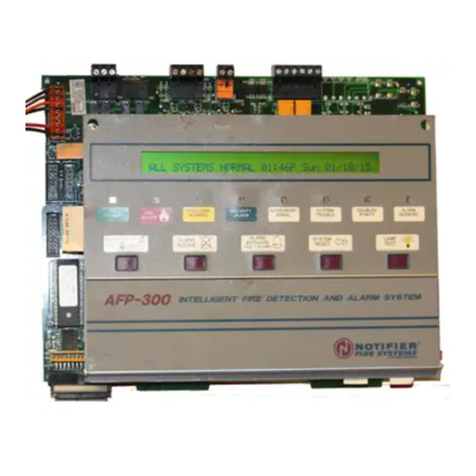
Notifier
Notifier UniNet 2000 AFP-300 NION instruction manual
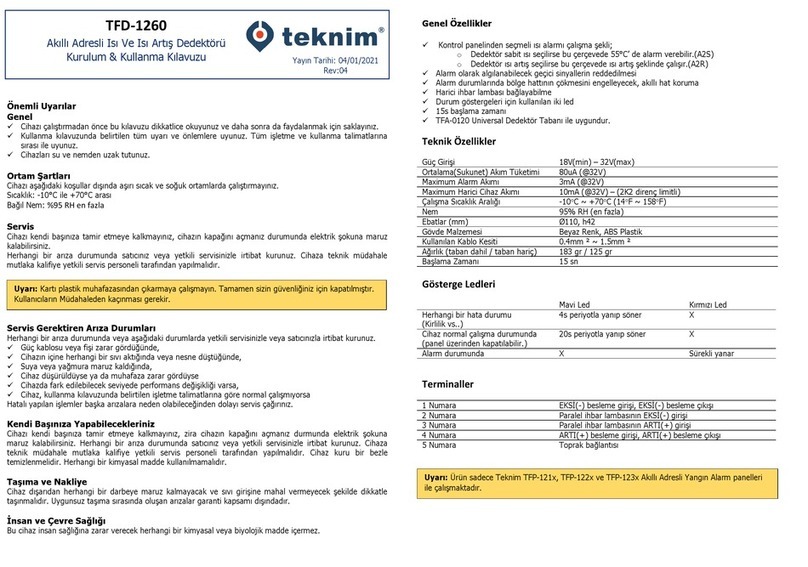
Teknim
Teknim TFD-1260 Installation & operating guide
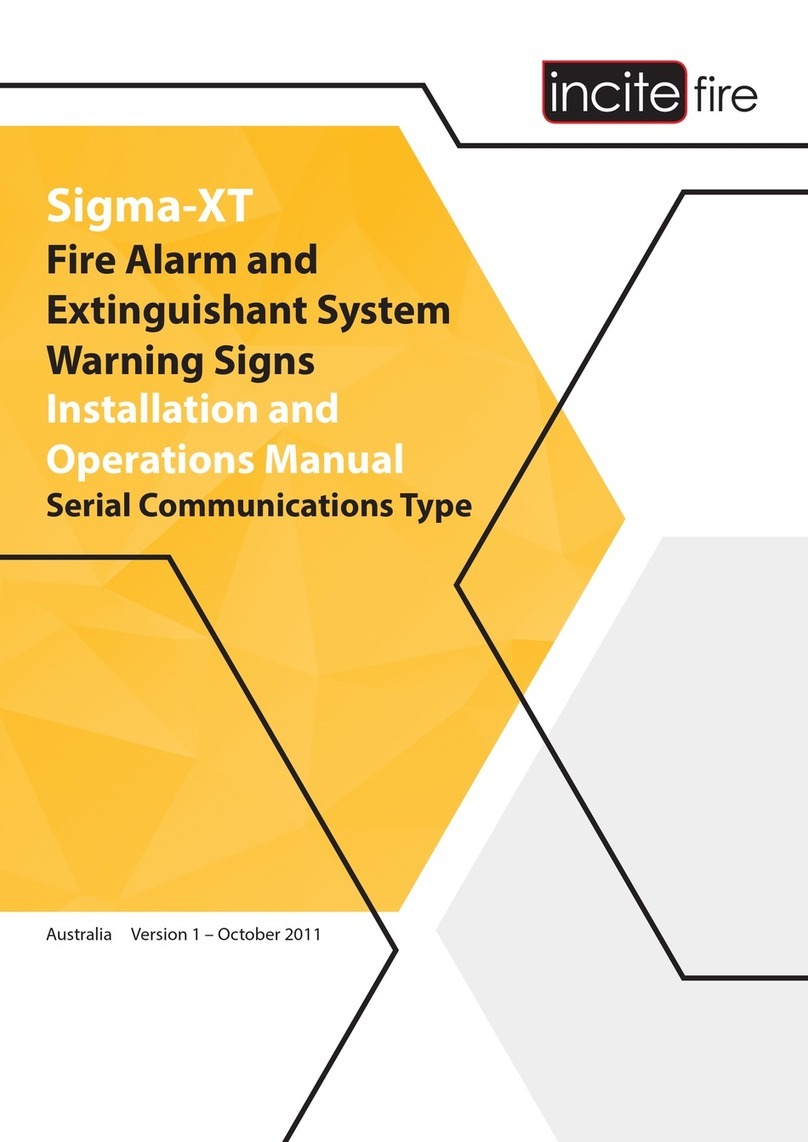
Incite Fire
Incite Fire Sigma-XT Installation and operation manual
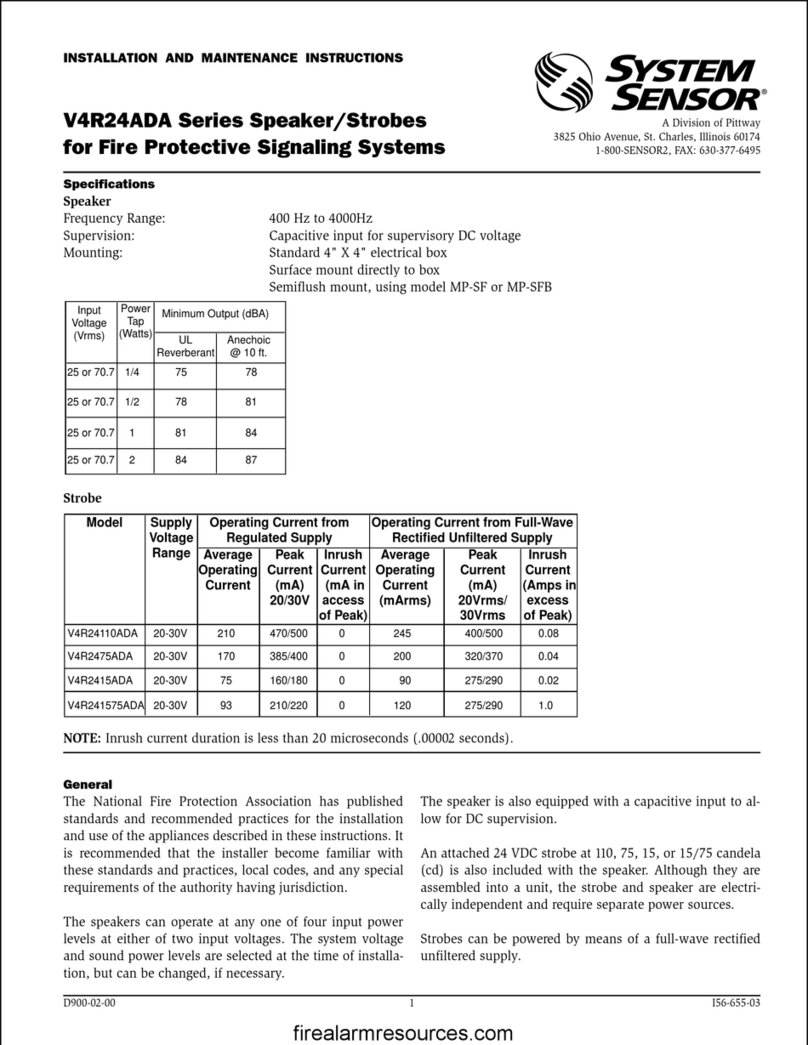
Pittway
Pittway System Sensor V4R24ADA Series Installation and maintenance instructions

Bosch
Bosch FAP-DO420 Operation guide
